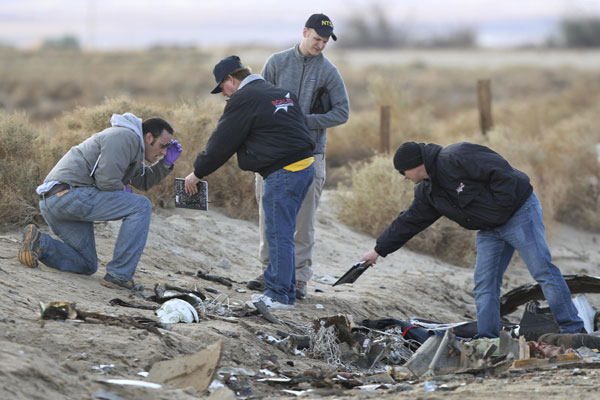Branson determined to find cause of Virgin spaceship crash, pilots identified
(Agencies) Updated: 2014-11-02 09:32New type of fuel
The Virgin probe will likely focus on SpaceShipTwo's rocket engine, which on Friday was flying with a new type of fuel for the first time, experts said.
 |
|
Investigators from the National Transportation Safety Board (NTSB) and Scale Composites inspect wreckage at one of the debris fields of the crash of Virgin Galactic's SpaceShipTwo near Cantil, California November 1, 2014. Billionaire entrepreneur Richard Branson said on Saturday he was determined to find out what caused the passenger spaceship being developed by his space tourism company to crash during a test flight in California, killing one pilot and injuring the other. Virgin Galactic's SpaceShipTwo went down during a powered test flight, scattering debris over the Mojave Desert, 95 miles (150 km) north of Los Angeles. [Photo/Agencies] |
The solid plastic-type propellant is ignited by nitrous oxide, commonly known as laughing gas.
Virgin Galactic announced in May that it was replacing the rubber-based propellant used during the spaceship's three previous rocket-powered test flights to get better performance.
"We've tested both of these fuel grains a lot," Virgin Galactic chief executive George Whitesides told Reuters at the time.
Before Friday's flight, SpaceShipTwo's last powered test flight was in January, though the rocket and its new propellant had passed multiple ground tests.
Virgin Galactic is a US offshoot of the London-based Virgin Group founded by Branson, one of the world's most famous entrepreneurs whose business empire ranges from airlines to music stores and mobiles phones.
Friday's accident marked the fourth fatality in Scaled's SpaceShipTwo development effort. In 2007, a fuel tank exploded, killing three Scaled employees.
"While not a NASA mission, the pain of this (new)tragedy will be felt by all the men and women who have devoted their lives to exploration," NASA, the US space agency, said in a statement.










